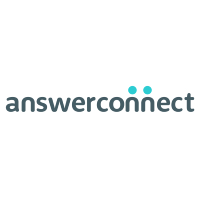 By Legal Futures Associate AnswerConnect
By Legal Futures Associate AnswerConnect
Legal practices are facing a conundrum; how to provide consistent, meaningful client services on a 24/7 basis, without the costs of hiring an entire team to work around the clock.
Outsourcing your client services to a call answering service – either using real people or AI – gives your legal practice the freedom to scale up your client services without the massive overheads of hiring an in-house team.
And that’s ultimately what all of these services are about. They give legal practices the client services clout of a multinational corporation, without the usual staffing costs.
But which is better for your legal practice? In this article, we’ll explore:
- The biggest differences between virtual and automated receptionists
- Which is right for your legal practice
- Some quick tips to help you get the most from either service.
So what factors do you need to consider when choosing between automated and human receptionists?
Coverage
Most legal practices first realise they need an answering solution when they start getting messages about missed calls and complaints about wait times. And regardless of why you missed it – due to high call volumes or the call coming in outside of office hours – a missed call can cost you.
Customers expect legal practices to offer round-the-clock coverage, but they also want real responses from real people. 78% of people prefer to talk to a person, be it by phone, live chat or email, as opposed to a bot.
Response times
How fast do bots answer? Pretty fast. In conversation, phone chatbots often leave a delay after being posed a question to ensure the customer has finished speaking, just as a human would. But in live chat, bots can provide an almost-instant response to questions. So instant – in fact – that some people are put off by the immediacy.
To counter this, chatbot programmers include an option to add “bot delays”. Bot – or message delays, as they’re also known – allow you to specify the amount of time (in seconds) that a bot waits before it sends the next message in the queue. These are often accompanied by “typing” bubbles to make it seem the chatbot is crafting an answer from scratch.
Depending on what system they use, legal practices without chatbots can take anywhere between three rings of the phone to 30 minutes. An answering service typically answers your calls a lot faster. That’s essential to customer satisfaction, with 82% of consumers rating an immediate response when they have a marketing or sales question as important or very important.
But the real question is, how quickly do both options resolve a query or issue? The answer will define which solution offers the best customer experience.
Customer satisfaction
Client satisfaction is a key differentiator for legal practices. As Jerry Fritz said, “You’ll never have a product or price advantage again. They can be too easily duplicated. But a strong client services culture cannot be copied.”
Chatbots can provide some level of satisfaction. For smaller legal practices that struggle to answer calls in under five minutes, chatbots offer a quick solution. Perhaps most importantly, they seem like a better alternative than just letting the line ring out.
But are chatbots really better than nothing? A 2021 international survey into consumer attitudes to AI has the answer; over 35% of consumers say automated services never resolve their problems. And while a quarter of consumers think AI is improving client services, 45% think it’s making the experience worse.
Versatility
People are adaptable. Bots operate in a binary sense. Despite the improvements in AI in a relatively short space of time, it still lacks the versatility of a person. Sure, AI is more capable than ever of recognising, processing and responding to different accents, syntax and language. But it’s still nowhere near the level of comprehension of a real person. Only people can interpret such a huge range of information and the myriad ways of communicating that information.
Take Facebook Messenger’s automated ‘M’ chatbot. Initially launched using a combination of automated replies and human input, M was envisaged as becoming fully AI within a few years. However, even at its maximum capacity, the platform never surpassed 30% automation.
While AI is becoming more versatile every day, it’s a long way from being able to adapt to the wide array of situations customers present on a daily basis.
ROI
In business, cost informs every decision. But the value of a product or service can be difficult to measure when you consider cost alone. So how does the return on investment between a virtual receptionist service and an automated chatbot stack up?
The cost of an automated chatbot service varies according to several factors. That includes the number of chats it participates in, the times it’s used and whether you opt for additional features like adding attachments or processing payments.
In comparison, virtual receptionist services tend to be priced per call or minute. Additional features like payment processing and appointment scheduling are usually included in your plan, but it’s important to check before signing any contracts.
Ultimately, you need to figure out how many sales you make a month before adding any kind of answering service, and how many you’d need to make after setting up the service.
But you also need to consider how it will affect your existing customers. Run customer satisfaction surveys before and after launching your answering service. It’s difficult to quantify what increased customer satisfaction means in terms of ROI. But, it’s worth considering what impact (if any) it could have on extending the customer lifetime value.
Lead capture and qualification
Gathering lead information is like drawing a breath for your company; without it, you won’t survive. But that information has to adequately serve your end goals. After all, if you can’t gather information accurately, how can you give callers definitive solutions to their queries?
For industries such as healthcare, patients can be more likely to divulge sensitive information truthfully than when speaking to a real person. But for other industries, the anonymity provided by an AI responder can encourage people to leave false information.
AI still has a narrow range of data-gathering tools, often offering callers just a limited number of options to choose from. But real life is often far more complex than a narrow range of choices.
Regardless of if you opt for an automated or a human answering service, you still need to ensure you’re getting the best service for your money.
So how do you do that?
How to optimise your answering service
- Set clear objectives – What do you want to achieve from this? Most people simply want their calls answered, but you can expand this to include conditional transfers and lead qualification, among other actions.
- Identify your elevation process – Who will calls be transferred to in your team? Of course, that depends on the nature of the call – is it a lead enquiring about a service, or an existing customer calling to complain?
- Keep it simple! – There’s a temptation to add as many different scripts as possible to cater for every possible scenario. But your answering service works best when it fulfils clear objectives. Plus, when the answering service is made up of real people, they can adapt to hundreds of unscripted scenarios while staying on-brand.
In summary
Ultimately, it’s up to you what solution is best for your business. But the data is unequivocal in the importance of offering real responses. People prefer it, and many countries are already drafting laws that make it a legal requirement to have a real person available for callers.
AnswerConnect’s huge team of client services experts are on hand 24/7 to give callers a professional response.
Book a free consultation with us today to find out what people-powered client services can do for your business.











